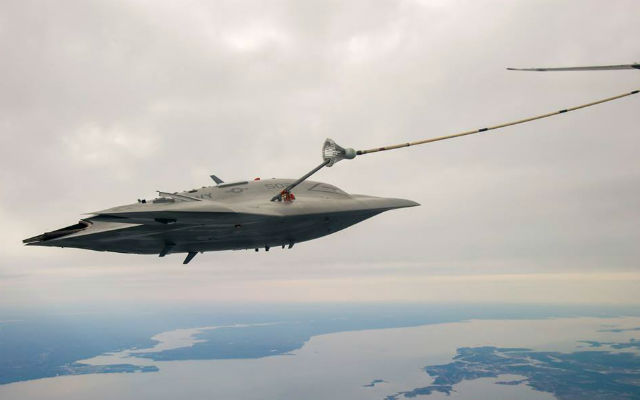 A risk-reduction request for proposals (RfP) for the US Navy’s MQ-25 unmanned air vehicle acquisition is expected to be released “this summer”, which will help set out the timeline in which the service can realistically expect the tanker system to be deployed on-board its carrier fleet.
A risk-reduction request for proposals (RfP) for the US Navy’s MQ-25 unmanned air vehicle acquisition is expected to be released “this summer”, which will help set out the timeline in which the service can realistically expect the tanker system to be deployed on-board its carrier fleet.
Speaking to Flightglobal at the AUVSI Xponential show in New Orleans, Louisiana on 3 May, RADM Mark Darrah, PEO Unmanned Aviation and Strike Weapons for the navy, said that the move from a stealth intelligence, surveillance and reconnaissance (ISR) strike aircraft to the tanker variant now being proposed has left questions over the availability of the technology and timeframe for its development.
The goal is to release a risk-reduction RfP this summer, which will be followed by an engineering, manufacturing and design RfP in early FY2017, he says.
The intent it still to speak to the same four bidders that were selected for the previous iteration of the programme – the unmanned carrier-launched airborne surveillance and strike, or UCLASS – and the risk-reduction RfP will seek information on the technology that the companies currently have, and how much it will cost.
Boeing, General Atomics Aeronautical Systems, Lockheed Martin and Northrop Grumman all have designs they were going to pitch for UCLASS, and are expected to modify them for the MQ-25’s new role.
“It’s giving us the opportunity to incorporate new ideas,” Darrah says, and the acquisition timeline will then be set out once this information is garnered from industry.
He notes that programme delays, such as the ones evident within the UCLASS programme, can sometimes provide opportunities for reassessment, and “we think there are some things that we learnt [from that]”.
“We are definitely trying to find that sweet spot in cost and schedule,” he says. “Our intent is to get this capability to the carriers as soon as possible.”
The navy is prioritising deploying the unmanned capability on the carriers as opposed to the stealth element, so redefined the requirements to acquire a refuelling ISR asset instead of a stealthy strike one. This is ultimately in line with what the navy’s Boeing F/A-18 Super Hornets currently do, and will alleviate the burden on the fighters so that they can carry out the strike role.
Elsewhere, the navy is also looking to utilise the capability of its smaller fleet of UAVs more, by “tying together” the assets into a common operational picture to standardise the way that data is communicated to those that need it.
“We continue to see a huge demand from the warfighter for unmanned capabilities at the company level,” Darrah says. The navy is targeting more cross-level use of systems such as the AeroVironment Puma and Wasp andHoneywell T-Hawk systems, to be able to deploy the most suitable ISR assets for each job.
This extends to including more payload options in the smaller systems, and Darrah notes that a key priority of the navy is to incorporate scalable technology from the larger platforms to the smaller ones.
He also praised the performance of the Insitu RQ-21 Blackjack UAV that is being deployed from the navy’s amphibious assault ships, that are providing “situational awareness that they never had”.
“We’ve learnt a lot about training, sustainment and spares from this,” he adds. This includes the logistics of ensuring stable take-off and landing of the UAV from the vessels, and countering the potential loss of GPS when at-sea.
The navy’s Northrop MQ-8B Fire Scout rotary-wing UAV is also performing well at sea as it deploys alongside the Lockheed MH-60R helicopter on the Littoral Combat Ships.
The number of people deployed on the ships has been decreased as a result of the unmanned option, which is in line with the navy’s desire to utilise these ISR assets more.
The final test of the larger MQ-8C is on track for FY17, and the campaign is “doing very well”, Darrah notes. The radar programme for the MQ-8C is also underway, and the navy is receiving early demonstrations of options.
A so-called Milestone C decision on the Northrop MQ-4C Triton high-altitude development is expected in June, meanwhile, which will lead on to low-rate initial production and a planned first deployment in FY18.
Source: Flightglobal
